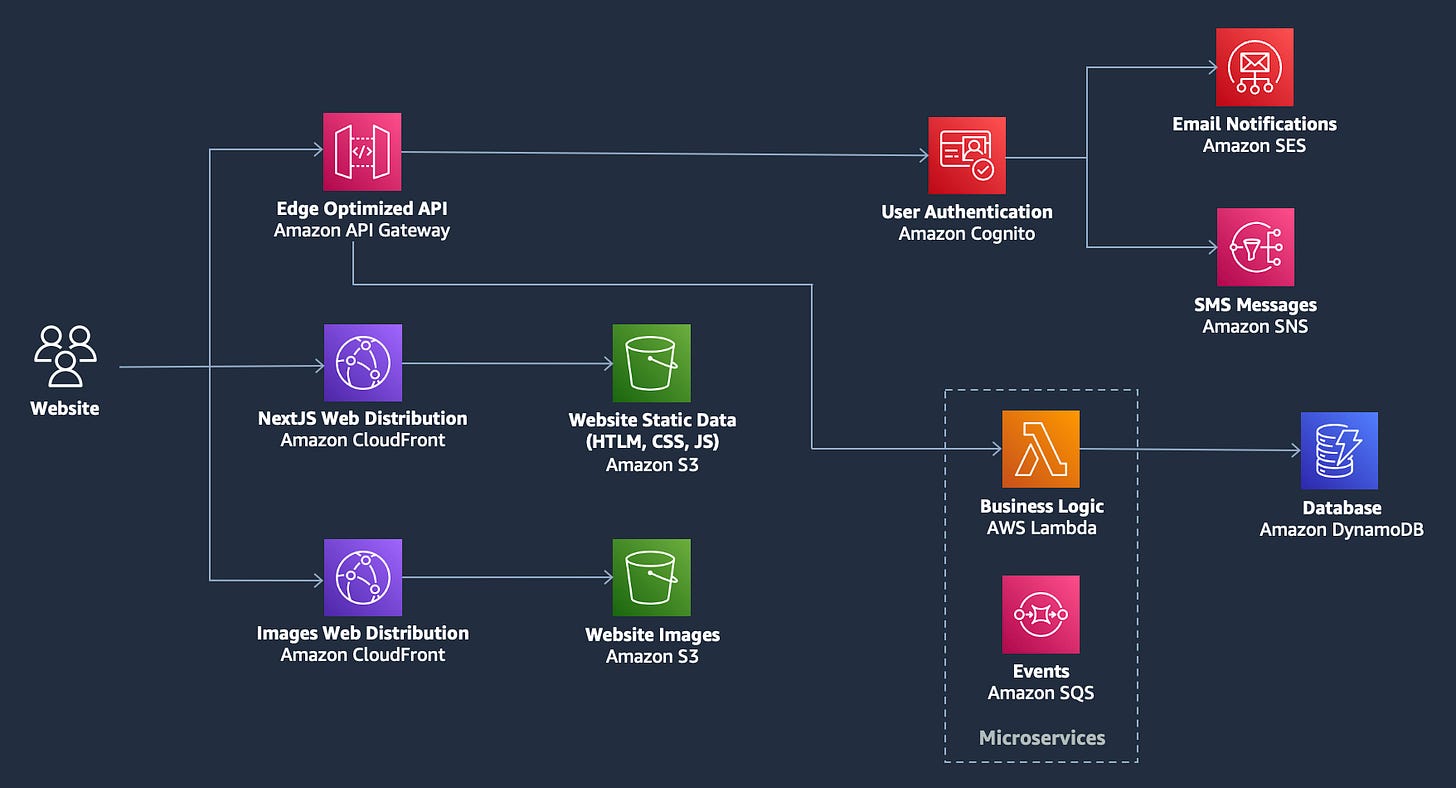How I Built a Complete Marketing Platform with AWS Serverless in Just 10 Months
In my journey as a Cloud Engineer, I've always been passionate about building efficient, scalable solutions that solve real business problems without breaking the bank. Today, I'm sharing how I built a complete Marketing platform for a startup I co-founded in 2019, using AWS Serverless technologies in just 10 months, with practical insights you can apply to your own projects.
The Project Requirements
When approaching this project, I worked backwards. Instead of jumping straight into coding or service selection, I started by defining the minimum technical requirements for the system:
1. Agility
I needed to develop an MVP rapidly, deliver new features quickly, fail fast when necessary, and move from development to production in minutes without worrying about breaking existing functionality. Time-to-market was critical for our business model.
2. Performance
Like everyone, I wanted a platform that was highly available, scalable, and performant. I set specific upper limits on concurrent users and defined performance metrics for page loads and API responses to ensure the architecture could handle our projected growth.
3. Cost
As a startup with limited funding, cost control was paramount. We needed a pay-as-you-go consumption model to keep development costs extremely low—under $100 per month for the MVP phase. This constraint alone eliminated many traditional architecture options.
4. Security
I needed enterprise-grade security built into the platform—something beyond what I could implement with my own skills. This meant leveraging AWS's built-in security features rather than trying to build custom security solutions.
Why Serverless Was the Perfect Fit
After considering our requirements, serverless architecture emerged as the clear winner for several key reasons:
Pay-per-use economics: We only paid for actual usage, not idle servers sitting around waiting for traffic.
Built-in scalability: The architecture would automatically scale up during traffic spikes and down during quiet periods.
Speed of development: With managed services handling infrastructure concerns, I could focus on business logic.
Reduced operational burden: No patching, monitoring, or scaling infrastructure meant fewer operational headaches.
Security by default: AWS's managed services come with built-in security features and compliance certifications.
The Architecture: Serverless Three-Tier with Microservices
The final architecture I designed follows a three-tier approach with a microservices pattern.
Let me walk you through how it all works:
Frontend Layer
When users load our website, they interact with:
Amazon CloudFront delivering cached content from S3 buckets for lightning-fast page loads
Amazon S3 hosting our static website and storing all marketing assets and images in separate buckets
This approach gave us global content delivery with minimal latency
API Layer
All user interactions flow through:
Edge-Optimized API Gateway leveraging CloudFront's global infrastructure to reduce latency worldwide
Amazon Cognito handling all authentication and user management, connected to Amazon SES for email verification and Amazon SNS for SMS communications during registration
This combination provided secure, scalable API management with minimal code
Business Logic Layer
The core functionality lives in:
AWS Lambda functions organized in a microservices pattern, each handling specific business capabilities
Amazon SQS enabling event-driven communication between services
This event-driven approach allowed us to scale individual functions independently based on demand
Data Layer
Everything is stored in:
Amazon DynamoDB serving as our primary database, with careful attention to access patterns and partition design
DynamoDB provided single-digit millisecond response times with virtually unlimited scaling potential
Challenges and Lessons Learned
While this architecture looks straightforward on paper, several challenges emerged during implementation:
Cold Start Times
Lambda cold starts were initially problematic for certain critical user flows. I addressed this by:
Implementing provisioned concurrency for critical functions
Breaking monolithic functions into smaller, more focused ones
Using connection pooling patterns for database access
DynamoDB Design
Designing DynamoDB tables correctly was essential. I spent significant time:
Analyzing access patterns before creating tables
Creating composite keys and indexes that supported our most common queries
Implementing sparse indexes to optimize performance
API Gateway Limits
We hit some API Gateway limits that required rethinking our approach:
Implementing request batching for high-volume operations
Using SQS for truly asynchronous operations
Carefully organizing our API resources to minimize integration points
The Results
After 10 months of development, we launched a complete Marketing platform that:
Costs under $200/month to operate at our current scale
Handles traffic spikes without any manual intervention
Allows us to deploy new features multiple times per day
Has maintained 99.99% uptime since launch
More importantly, the serverless approach allowed us to focus on building features that matter to our customers rather than managing infrastructure.
Conclusion
Building a Marketing platform with AWS serverless technologies demonstrated that you don't need large teams or massive budgets to create sophisticated, scalable applications. By leveraging the right services and embracing event-driven architecture, we built a platform that can compete with solutions from much larger companies.
The serverless paradigm continues to prove itself as a viable approach for startups and enterprises alike, offering the flexibility, scalability, and cost-effectiveness that modern businesses require.


